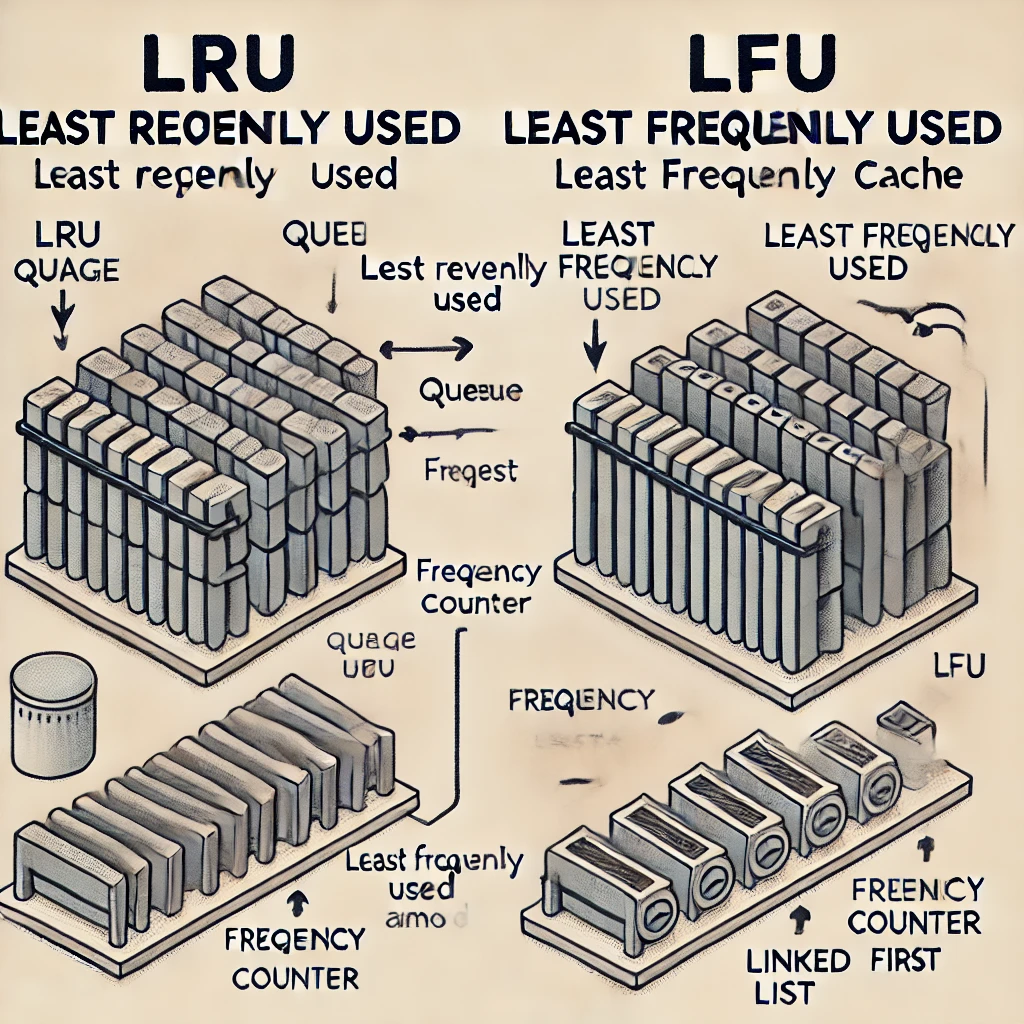LRU
LRU(Least Recently Used)是一种常见的缓存替换算法,主要用于管理缓存中的数据。当缓存达到容量限制时,LRU算法会选择最久未被访问的数据进行淘汰,从而为新数据腾出空间。
工作原理
LRU算法基于“最近最少使用”策略,通过跟踪数据的访问顺序来判断哪些数据最不常用。每当数据被访问时,它就会被移动到缓存的最前面或标记为最近使用。缓存满时,LRU会删除最久没有被访问的数据。
实现方式
LRU缓存通常通过双向链表和哈希表结合实现,具体步骤如下:
哈希表:通过哈希表快速查找缓存中的数据。
双向链表:通过双向链表保持数据的访问顺序。链表的尾部表示最近使用的数据,头部表示最久未使用的数据。
增加虚拟头节点和虚拟尾节点,不存储数据。
当数据被访问时,将该数据节点移动到链表的尾部。(本文代码将被访问的数据移动至尾部)
当缓存满时,删除链表头部的节点。
LRU缓存:通过Golang中的map和自定义的双向链表实现。
访问数据判断数据是否存在
存在,覆盖数据,将数据移动到链表尾部,表示最近访问。
不存在,返回错误
插入数据判断数据是否存在
存在,删除旧数据,创建新数据
不存在,创建新数据
节点结构
// 节点结构
type Node struct {
key, val int
next, prev *Node
}
func NewNode(k, v int) *Node {
return &Node{key: k, val: v}
}双向链表结构及对应方法
// 双链表
type DoubleList struct {
head, tail *Node
size int
}
func NewDoubleList() *DoubleList {
head := &Node{key: 0, val: 0}
tail := &Node{key: 0, val: 0}
head.next, tail.prev = tail, head
return &DoubleList{head: head, tail: tail, size: 0}
}
// 在链表尾部添加节点x, 时间O(1)
// 将x插入尾节点之前
func (this *DoubleList) AddLast(x *Node) {
x.prev = this.tail.prev
x.next = this.tail
this.tail.prev.next = x
this.tail.prev = x
this.size++
}
// 删除链表中的x节点(x一定存在)
func (this *DoubleList) Remove(x *Node) {
x.prev.next = x.next
x.next.prev = x.prev
this.size--
}
// 删除链表中的第一个节点,并返回该节点,时间O(1)
func (this *DoubleList) RemoveFirst() *Node {
if this.head.next == this.tail {
return nil
}
first := this.head.next
this.Remove(first)
return first
}
// 返回链表长度
func (this *DoubleList) Size() int {
return this.size
}LRU缓存及方法
// 构建缓存结构体
type LRUCache struct {
_map map[int]*Node
cache *DoubleList
// 最大容量
cap int
}
func Constructor(capacity int) LRUCache {
return LRUCache{
_map: make(map[int]*Node),
cache: NewDoubleList(),
cap: capacity,
}
}
// 将某个key提升为最近使用的
func (this *LRUCache) makeRecently(key int) {
x := this._map[key]
this.cache.Remove(x)
this.cache.AddLast(x)
}
// 添加最近使用的元素
func (this *LRUCache) addRecently(key, val int) {
x := NewNode(key, val)
this.cache.AddLast(x)
this._map[key] = x
}
// 删除某个key
func (this *LRUCache) deleteKey(key int) {
x := this._map[key]
this.cache.Remove(x)
delete(this._map, key)
}
// 删除最久未使用(头节点)元素
func (this *LRUCache) removeLeaseRecently() {
x := this.cache.RemoveFirst()
delete(this._map, x.key)
}
func (this *LRUCache) Get(key int) int {
if _, ok := this._map[key]; !ok {
return -1
}
this.makeRecently(key)
return this._map[key].val
}
func (this *LRUCache) Put(key, val int) {
if _, ok := this._map[key]; ok {
// 删除旧的节点
this.deleteKey(key)
this.addRecently(key, val)
return
}
if this.cap == this.cache.Size() {
this.removeLeaseRecently()
}
this.addRecently(key, val)
}完整代码
package main
import "fmt"
// 节点结构
type Node struct {
key, val int
next, prev *Node
}
func NewNode(k, v int) *Node {
return &Node{key: k, val: v}
}
// 双链表
type DoubleList struct {
head, tail *Node
size int
}
func NewDoubleList() *DoubleList {
head := &Node{key: 0, val: 0}
tail := &Node{key: 0, val: 0}
head.next, tail.prev = tail, head
return &DoubleList{head: head, tail: tail, size: 0}
}
// 在链表尾部添加节点x, 时间O(1)
// 将x插入尾节点之前
func (this *DoubleList) AddLast(x *Node) {
x.prev = this.tail.prev
x.next = this.tail
this.tail.prev.next = x
this.tail.prev = x
this.size++
}
// 删除链表中的x节点(x一定存在)
func (this *DoubleList) Remove(x *Node) {
x.prev.next = x.next
x.next.prev = x.prev
this.size--
}
// 删除链表中的第一个节点,并返回该节点,时间O(1)
func (this *DoubleList) RemoveFirst() *Node {
if this.head.next == this.tail {
return nil
}
first := this.head.next
this.Remove(first)
return first
}
// 返回链表长度
func (this *DoubleList) Size() int {
return this.size
}
// 构建缓存结构体
type LRUCache struct {
_map map[int]*Node
cache *DoubleList
// 最大容量
cap int
}
func Constructor(capacity int) LRUCache {
return LRUCache{
_map: make(map[int]*Node),
cache: NewDoubleList(),
cap: capacity,
}
}
// 将某个key提升为最近使用的
func (this *LRUCache) makeRecently(key int) {
x := this._map[key]
this.cache.Remove(x)
this.cache.AddLast(x)
}
// 添加最近使用的元素
func (this *LRUCache) addRecently(key, val int) {
x := NewNode(key, val)
this.cache.AddLast(x)
this._map[key] = x
}
// 删除某个key
func (this *LRUCache) deleteKey(key int) {
x := this._map[key]
this.cache.Remove(x)
delete(this._map, key)
}
// 删除最久未使用(头节点)元素
func (this *LRUCache) removeLeaseRecently() {
x := this.cache.RemoveFirst()
delete(this._map, x.key)
}
func (this *LRUCache) Get(key int) int {
if _, ok := this._map[key]; !ok {
return -1
}
this.makeRecently(key)
return this._map[key].val
}
func (this *LRUCache) Put(key, val int) {
if _, ok := this._map[key]; ok {
// 删除旧的节点
this.deleteKey(key)
this.addRecently(key, val)
return
}
if this.cap == this.cache.Size() {
this.removeLeaseRecently()
}
this.addRecently(key, val)
}
func main() {
// 创建一个容量为 2 的 LRU 缓存
cache := Constructor(2)
// 插入数据
cache.Put(1, 1) // 缓存: [1=1]
cache.Put(2, 2) // 缓存: [1=1, 2=2]
// 获取 key 1 的值,应返回 1
fmt.Println(cache.Get(1)) // 输出 1
// 插入数据 3,会将 key 2 删除,因为容量限制
cache.Put(3, 3) // 缓存: [1=1, 3=3]
// 获取 key 2 的值,应该返回 -1(因为 key 2 被删除)
fmt.Println(cache.Get(2)) // 输出 -1
// 插入数据 4,会将 key 1 删除,因为 key 1 是最久未使用的
cache.Put(4, 4) // 缓存: [3=3, 4=4]
// 获取 key 1 的值,应该返回 -1(因为 key 1 被删除)
fmt.Println(cache.Get(1)) // 输出 -1
// 获取 key 3 的值,应该返回 3
fmt.Println(cache.Get(3)) // 输出 3
// 获取 key 4 的值,应该返回 4
fmt.Println(cache.Get(4)) // 输出 4
// 插入数据 5,将删除最久未使用的 key 3
cache.Put(5, 5) // 缓存: [4=4, 5=5]
// 获取 key 3 的值,应该返回 -1(因为 key 3 被删除)
fmt.Println(cache.Get(3)) // 输出 -1
// 获取 key 4 和 key 5 的值
fmt.Println(cache.Get(4)) // 输出 4
fmt.Println(cache.Get(5)) // 输出 5
}
LFU
LFU(Least Frequently Used)算法
LFU(Least Frequently Used)是一种缓存替换算法,主要用于淘汰最少使用的数据。当缓存空间满时,LFU会选择访问频率最低的数据进行删除,从而为新数据腾出空间。不同于LRU(Least Recently Used)依赖于数据的访问顺序,LFU关注的是数据的访问频率。
工作原理
LFU算法通过维护数据项的访问频率,来确定哪些数据是最不常用的。每个数据都会被分配一个计数器,表示该数据被访问的次数。当缓存满时,LFU会选择访问频率最小的数据进行淘汰。需要注意的是,如果有多个数据的访问频率相同,则需要根据其他标准(例如最近访问的时间)来决定哪些数据应该被淘汰。
实现方式
主要数据结构
keyToVal:保存每个
key对应的值。keyToFreq:保存每个
key对应的访问频率。freqToKeys:保存每个访问频率对应的
key列表,列表维护着具有相同频率的key,可以根据访问顺序来删除最久未使用的key。keyToNode:用于将
key映射到频率链表中的具体位置,帮助我们在 O(1) 的时间复杂度下删除key。minFreq:记录当前缓存中的最小频率。
cap:缓存的最大容量。
size:当前缓存的大小。
type LFUCache struct {
// key 到 val 的映射
keyToVal map[int]int
// key 到 freq(访问次数、频率)的映射
keyToFreq map[int]int
// freq 到 key的映射,返回相同freq下的key值列表,用于查找最旧的数据
freqToKeys map[int]*list.List
// 记录最小的频率
minFreq int
// 记录LFU缓存的最大容量
cap int
// 当前缓存的大小
size int
// key 到其所在列表中元素的映射,用于O(1)删除,存储list的数据,用于查询后删除,创建后添加操作
keyToNode map[int]*list.Element
}主要操作
构造函数:初始化缓存。
Get操作:获取缓存的值,如果存在则返回其值并增加访问频率。如果不存在返回
-1。Put操作:如果
key存在则更新其值并增加访问频率,如果key不存在则插入新值,且在缓存满时进行淘汰操作。removeMinFreqKey:删除最小频率的
key,当缓存已满时调用该方法来淘汰最不常用的缓存项。increaseFreq:增加
key的访问频率,并将其从当前频率的列表中移动到频率更高的列表。
// 构造LFU缓存
func Constructor(capacity int) LFUCache {
return LFUCache{
keyToVal: make(map[int]int),
keyToFreq: make(map[int]int),
freqToKeys: make(map[int]*list.List),
keyToNode: make(map[int]*list.Element),
cap: capacity,
size: 0,
minFreq: 0,
}
}
// 删除使用最小频率的key
func (this *LFUCache) removeMinFreqKey() {
// 获取freq最小的key列表
keys := this.freqToKeys[this.minFreq]
// 删除最先插入的key
node := keys.Front()
deleteKey := node.Value.(int)
// 开始逐步删除
keys.Remove(node)
if keys.Len() == 0 {
delete(this.freqToKeys, this.minFreq)
}
delete(this.keyToVal, deleteKey)
delete(this.keyToFreq, deleteKey)
delete(this.keyToNode, deleteKey)
this.size--
}
// 增加key的访问次数
func (this *LFUCache) increaseFreq(key int) {
freq := this.keyToFreq[key]
this.keyToFreq[key] = freq + 1
node := this.keyToNode[key]
fmt.Println(node)
fmt.Println("------------")
fmt.Println(*this.freqToKeys[freq])
this.freqToKeys[freq].Remove(node)
if this.freqToKeys[freq].Len() == 0 {
delete(this.freqToKeys, freq)
if freq == this.minFreq {
this.minFreq++
}
}
if _, ok := this.freqToKeys[freq+1]; !ok {
this.freqToKeys[freq+1] = list.New()
}
this.keyToNode[key] = this.freqToKeys[freq+1].PushBack(key)
}
// Get操作
func (this *LFUCache) Get(key int) int {
if _, ok := this.keyToVal[key]; !ok {
return -1
}
this.increaseFreq(key)
return this.keyToVal[key]
}
// Put操作
func (this *LFUCache) Put(key, val int) {
if this.cap <= 0 {
return
}
// key存在,将覆盖原来的值
if _, ok := this.keyToVal[key]; ok {
this.keyToVal[key] = val
this.increaseFreq(key)
return
}
// 如果key不存在
// 1. 容量已满。删除最少访问次数的元素
if this.cap <= this.size {
this.removeMinFreqKey()
}
// 逐步插入
this.keyToVal[key] = val
this.keyToFreq[key] = 1
if _, ok := this.freqToKeys[1]; !ok {
this.freqToKeys[1] = list.New()
}
this.keyToNode[key] = this.freqToKeys[1].PushBack(key)
this.minFreq = 1
this.size++
}完整代码
package main
import (
"container/list"
"fmt"
)
type LFUCache struct {
// key 到 val 的映射
keyToVal map[int]int
// key 到 freq(访问次数、频率)的映射
keyToFreq map[int]int
// freq 到 key的映射,返回相同freq下的key值列表,用于查找最旧的数据
freqToKeys map[int]*list.List
// 记录最小的频率
minFreq int
// 记录LFU缓存的最大容量
cap int
// 当前缓存的大小
size int
// key 到其所在列表中元素的映射,用于O(1)删除
keyToNode map[int]*list.Element
}
// 构造LFU缓存
func Constructor(capacity int) LFUCache {
return LFUCache{
keyToVal: make(map[int]int),
keyToFreq: make(map[int]int),
freqToKeys: make(map[int]*list.List),
keyToNode: make(map[int]*list.Element),
cap: capacity,
size: 0,
minFreq: 0,
}
}
// 删除使用最小频率的key
func (this *LFUCache) removeMinFreqKey() {
// 获取freq最小的key列表
keys := this.freqToKeys[this.minFreq]
// 删除最先插入的key
node := keys.Front()
deleteKey := node.Value.(int)
// 开始逐步删除
keys.Remove(node)
if keys.Len() == 0 {
delete(this.freqToKeys, this.minFreq)
}
delete(this.keyToVal, deleteKey)
delete(this.keyToFreq, deleteKey)
delete(this.keyToNode, deleteKey)
this.size--
}
// 增加key的访问次数
func (this *LFUCache) increaseFreq(key int) {
freq := this.keyToFreq[key]
this.keyToFreq[key] = freq + 1
node := this.keyToNode[key]
fmt.Println(node)
fmt.Println("------------")
fmt.Println(*this.freqToKeys[freq])
this.freqToKeys[freq].Remove(node)
if this.freqToKeys[freq].Len() == 0 {
delete(this.freqToKeys, freq)
if freq == this.minFreq {
this.minFreq++
}
}
if _, ok := this.freqToKeys[freq+1]; !ok {
this.freqToKeys[freq+1] = list.New()
}
this.keyToNode[key] = this.freqToKeys[freq+1].PushBack(key)
}
// Get操作
func (this *LFUCache) Get(key int) int {
if _, ok := this.keyToVal[key]; !ok {
return -1
}
this.increaseFreq(key)
return this.keyToVal[key]
}
// Put操作
func (this *LFUCache) Put(key, val int) {
if this.cap <= 0 {
return
}
// key存在,将覆盖原来的值
if _, ok := this.keyToVal[key]; ok {
this.keyToVal[key] = val
this.increaseFreq(key)
return
}
// 如果key不存在
// 1. 容量已满。删除最少访问次数的元素
if this.cap <= this.size {
this.removeMinFreqKey()
}
// 逐步插入
this.keyToVal[key] = val
this.keyToFreq[key] = 1
if _, ok := this.freqToKeys[1]; !ok {
this.freqToKeys[1] = list.New()
}
this.keyToNode[key] = this.freqToKeys[1].PushBack(key)
this.minFreq = 1
this.size++
}
func main() {
cache := Constructor(2)
cache.Put(1, 1) // 缓存是 {1=1}
cache.Put(2, 2) // 缓存是 {1=1, 2=2}
fmt.Println(cache.Get(1)) // 返回 1
cache.Put(3, 3) // 删除键 2,缓存是 {1=1, 3=3}
fmt.Println(cache.Get(2)) // 返回 -1 (未找到)
cache.Put(4, 4) // 删除键 1,缓存是 {3=3, 4=4}
fmt.Println(cache.Get(1)) // 返回 -1 (未找到)
fmt.Println(cache.Get(3)) // 返回 3
fmt.Println(cache.Get(4)) // 返回 4
}


